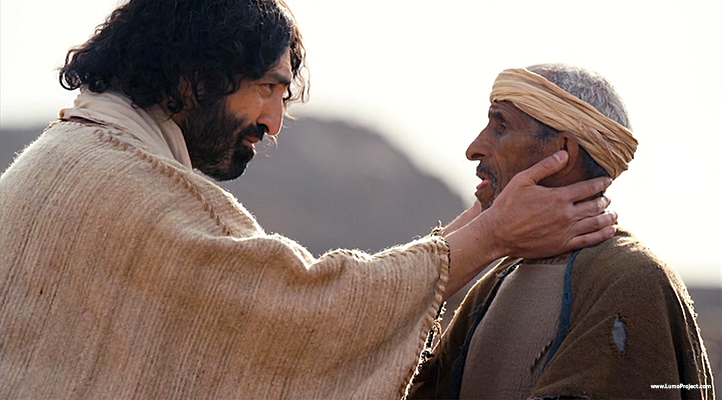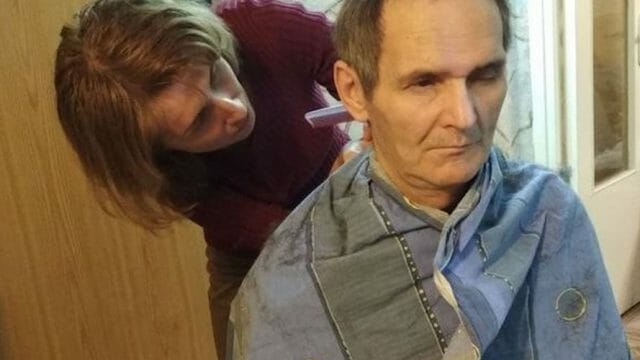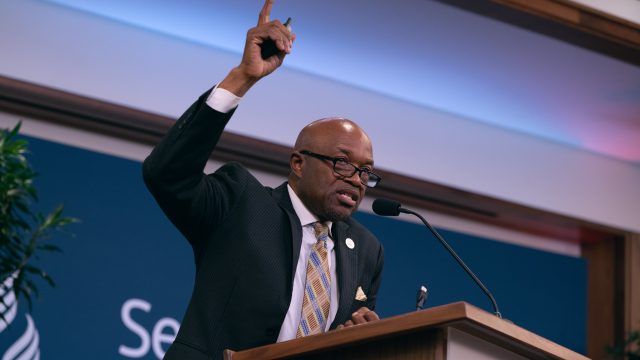Jesus’ practical approach to hearing and sight-impaired individuals

The deaf man knew that something important was happening. If only he could hear and understand what his friends were talking about! With excited gestures they pointed in the distance to a group approaching the town and pushed him toward the arriving visitors. Brown dust from the hurried feet filled the air and the man coughed, one of the few sounds he could make with his mouth.
At last the crowd met the travelers; all the attention was focused on one Man. The deaf man surmised that He must be someone of importance and influence, yet He appeared to be as ordinary and travel-worn as His companions. His friends seemed to be appealing to this Man for something. They brought the Man to him and stood, waiting.
The Stranger smiled knowingly and gently to the confusion of the crowd, led the deaf man to a quiet place away from the clamorous group. The deaf man studied His face as they walked—kindness was etched in the lines of the weary face. They stopped, and the Stranger turned toward him, commanding his complete attention. It seemed that the Stranger was going to do something to or for him. Holding His fingers up in front of the deaf man, He thrust them into his ears.1 The deaf man jumped at the sensation. What was the Stranger doing to his ears? Was He putting something inside of them? The unusual behavior continued. The Stranger spat on the ground and then, gesturing that the deaf man should open his mouth, touched his tongue. What was the Stranger doing to his mouth?
Then the strange Man looked up to the sky and sighed so deeply that the deaf man could see the rise and fall of His chest. His mouth formed a word, and as the last “a” of “Ephphatha” was still leaving His mouth, the deaf man heard a sound, a voice. At once, it all made sense. This Man, whoever He was, had healed his ears. He could hear! But his mouth, the stranger had also touched his mouth. Could he perhaps now speak as well as hear? He moved his tongue to form words and, to his joy, heard his own voice speaking. He was healed!
An Elaborate Healing Process
The stories of the deaf man in Mark 7:31–37 and the blind man in 8:22–26 have always puzzled me. Why the elaborate healing process, and for whose benefit? Was Jesus using these healings as parables to convict the disciples of their lack of faith (Mark 8:18)? Richard Lenski in The Interpretation of St. Mark’s Gospel suggests that Jesus was actually using a form of sign language to communicate to the deaf man in Mark 7 and later the blind man in Mark 8. Jesus took His time healing these men and used signs/touch to communicate what He was doing for them.2
The deaf man was at a distinct disadvantage in terms of communication, since he could not hear his friends’ explanations of Jesus’ power to heal. He would have surely sensed their excitement at Jesus’ coming, but likely did not understand what all the commotion was about. Jesus’ act of taking him aside at once signaled that Jesus was going to do something to or for him. Instead of explaining what He was going to do in words, which would have been meaningless to the deaf man, or simply laying His hand on him as the crowd desired Him to do (Mark 7:32), Jesus took the time to impress upon the man—using a kind of sign language—that something was about to be done to his ears and his mouth.3 With Jesus’ sigh toward heaven, the deaf man understood that whatever was being done to him was a divine act.4
The healing of the blind man in Mark 8 parallels the deaf man’s healing in many ways. Just as the people brought the deaf man to Jesus and “begged” (parakalousin) Him to lay His hand on him (Mark 7:32), so the people in Bethsaida brought the blind man to Jesus and “begged” (parakalousin) Him to touch him (Mark 8:22). Rather than healing him in the middle of an excited crowd, where the deaf man might be distracted, Jesus took him aside privately (Mark 7:33); likewise Jesus took the blind man out of the village before healing him (Mark 8:23). Spit, which was used as a sign that Jesus would be doing something to the deaf man’s mouth, is again featured in the healing of the blind man. This time, Jesus spat on his eyes (rather than on the ground) and then laid His hands on him (Mark 8:23).5
Interestingly, the healing of the blind man occurs gradually. At first, when Jesus asks, “Do you see anything?” the man does not see clearly. But after Jesus’ second touch, the man’s sight is fully restored. This does not seem to indicate that the man’s faith was lacking and needed time to grow or that Jesus was unable to heal him the first time around. Rather, this gradual healing emphasizes to the man that healing, complete healing, is taking place at Jesus’ hands. Just as Jesus used sign language to communicate with the deaf man, so this gradual healing communicated to the blind man that Jesus was the source of his healing.
Tell No One
Both healings end in a threefold manner. First, the diseased part of the body is opened (ears—Mark 7:35; eyes—Mark 8:25); then proper function is restored (tongue released—Mark 7:35; sight restored—Mark 8:25); and finally the healing is complete (spoke plainly—Mark 7:35; saw everything clearly—Mark 8:25). Jesus then dismisses both men with the explicit or implicit command not to tell anyone. To the deaf man and observers, “Jesus commanded them not to tell anyone” (Mark 7:36)6. The blind man he simply sent home with the command “Do not even go into the village” (Mark 8:26).
Commentators have noted that these two stories, which occur only in the Gospel of Mark,
“provide more detailed information about the manner of Jesus’ healing than any other narratives in the Gospels.”7Indeed, there is something special about them. While we see many instances of Jesus healing by a word, a touch of the hand, or even a touch of His garment, these healings are earthy and intimate. They remind us of another time, long before, when God took clay and fashioned the first man. These healings celebrate “God’s creative power in action.” The healing of the deaf and speech-impaired man “was a case of divine intervention, that is, God intervening in repairing the eardrum and the tongue that was damaged by Satan. . . . It is noteworthy that Jesus thrust his fingers into the man’s ear which was an expression of God’s direct and concrete intervention in the affairs of this man.”8
Jesus’ sensitivity to the needs of the deaf and speech-impaired man and the blind man should encourage us to be aware of the needs of those around us. Communicating the gospel can take many forms and should be adapted as necessary. Jesus used every opportunity and every means necessary to proclaim His message of redemption. As His followers, we are called to do the same.
1 The Greek word ballō is used here, which can mean “put” or “place.” In this context, it probably means “thrust,” which is much more forceful and indicates the power and authority with which Jesus is acting.
2 Richard C. H. Lenski, The Interpretation of St. Mark’s Gospel (Minneapolis, Minn: Augsburg Publishing House, 1964), pp. 308-313, 328-332.
3 C. S. Keener, The IVP Bible Background Commentary: New Testament (Downers Grove, Ill.: InterVarsity Press, (1993), pp. 154, 155.
4 Lenski, pp. 308-313. Ellen White notes an additional reason for Jesus’ sigh: “Looking up to heaven, He sighed at thought of the ears that would not be open to the truth, the tongues that refused to acknowledge the Redeemer.”— Ellen G. White, The Desire of Ages (Mountain View, Calif.: Pacific Press Pub. Assn., 1898, 1940), p. 404.
5 Karelynne Gerber Ayayo, “Magical Expectations and the Two-Stage Healing of Mark 8,” Bulletin for Biblical Research 24.3 (2014), pp. 381, 382.
6 All texts are from the Holy Bible, New International Version. Copyright ã 1973, 1978, 1984, 2011 by Biblica, Inc. Used by permission. All rights reserved worldwide.
7 Ayayo, p. 382.
8 Olugbenga Olagunju, “Jesus’ Healing Miracles in Mark 7:31-37 in an African Context,” Ogbomoso Journal of Theology XVIII, no. 1 (2013), p. 78.








